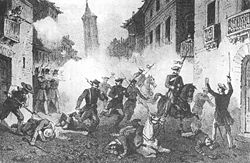- Cincomarzada
-
Cincomarzada Part of First Carlist War 
soldiers and citizens shoot at carlist soldiers retreatingDate 5th March of 1838 Location Zaragoza, Spain Result Liberal victory Belligerents  Carlists
Carlists Liberals
LiberalsCommanders and leaders Juan Cabañero y Esponera None, spontaneous uprising Strength 2,800 infantry men
300 cavalry menUnknown The Cincomarzada is a failed carlist attempt to conquer the city of Zaragoza on 5 March 1838. Nowadays is a popular holiday in Zaragoza commemorating the heroic behaviour of the citizens during the First Carlist War.
Contents
Background
Zaragoza was a very strategic position, garrisoned by a good number of liberal troops. As the carlist army was supposed to be far away, most of the garrison soldiers were sent in February 1838 to strengthen an army that had to fight against Basilio Garcia's expedition, who was trying to reach the Maestrazgo and join with Cabrera from La Mancha. When Cabrera heard that Zaragoza was almost defenceless, he sent Juan Cabañero y Esponera to seize the city with two thousand eight hundred infantry men and three hundred cavalry men. He only wanted to plunder the city, as those men were not enough to keep Zaragoza for long in carlist hands.
Battle
The night of 5 March 1838, Juan Cabañero's troops occupied most of the city by surprise, but faced to the resistance of its inhabitants and the news that the garrisons were coming back, the carlist fled. After the failure of the carlist army, the city received the title of "Siempre Heroica" (always heroic) and a street was named after this day (Cinco de Marzo).
Curiosities
It is said that after seizing the city, Cabañero ordered a hot chocolate, but he had to run away before tasting it. In 1840, when he had already joined the Liberals and he went to Zaragoza as part of the Liberal Army to fight against Cabrera, the zaragozans were shouting at him: "Cabañero, your chocolate is already cold!"
To read
Gustave D'Alaux. "Aragón visto por un francés durante la Primera Guerra Carlista." Zaragoza, 1985 - Translation of L'Aragon pendant la guerre civile. Revue des deux mondes, 15 February 1846.
Traditional festivals in Spain Major traditional festivals Albacete Fair · Batalla de flores · Bonfires of Saint John · Carnival of Cádiz · Carnival of Santa Cruz de Tenerife · Cavalcade of Magi · Chiviri · Cincomarzada · Coso Blanco · Cider Festival · Descenso del Sella · Falles · Feast of the Pirates of Premià de Mar · Fiestas de San Juan · Fiestas del Pilar · Haro Wine Festival · Hita Medieval Festival · Holy Week · Horse Fair · Horse Racing of Sanlúcar Beach · Los Campanos · Maruxaina · La Mercè · Misteri d'Elx · Moros y cristianos · Paso del Fuego · Patum de Berga · Powder Day · Romería de El Rocío · Saint John of the Mountain Festival · Santa Tecla Festival · San Fermín · Seville Fair · Tamborrada · Tarragona Fireworks Competition · Tomatina · Andra Mari Zuriaren JaiakOther related topics Musical events Music festivalsCategories:- Zaragoza
- Holidays in Spain
- First Carlist War
Wikimedia Foundation. 2010.
